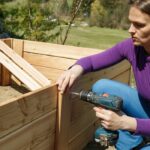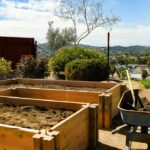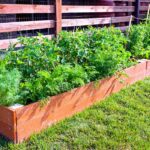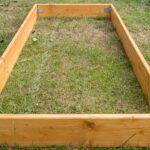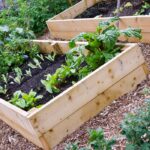After you have decided you want a raised garden bed, you need to figure out where it will go and how it will be set up. Understanding the components of what makes a garden thrive, such as sunlight and water, is not the only thing you need to consider. With a raised garden bed, you can determine your mobility and consider it too.
A raised bed needs 6 hours of sunlight daily, with ample water availability either by hose or irrigation system. The space’s measurements should be considered as what you want to plant. From root vegetables to leafy greens, each plant has its unique requirements as well.
A raised garden bed can have vegetables or flowers, all with their own needs and requirements to flourish. Yet that is not the only thing to consider. With a raised garden bed, you can determine your yard’s look and how many raised beds you want. From who will tend the garden and their specific needs to how the space will look afterward, we can all determine where the raised garden bed will go.
What is the Best Spot to Put a Raised Garden Bed?

There are many factors when deciding where to put your raised garden bed. Things like sunlight, water accessibility, convenience, and aesthetics are all crucial aspects of gardening you need to consider when finding the best spot for your raised garden bed.
The perfect place consists of all four aspects.
- First, you want excellent sun exposure, but depending on what you want to plant, that sunlight could be full or partial.
- You want to ensure easy access to a hose or another form of water since no one wants to carry a water bucket back and forth daily.
- There is also the convenience of its location. The further from the house, or the harder it is to get to the garden bed, the more likely it will be neglected, and weeds could take over.
- Lastly, you want the garden bed to look good. The type of wood or other materials it’s made out of, the shape, and the location can all play into aspects of appearance. Everyone wants their yard to look good, and a raised garden bed can help turn a boring backyard into a lively and colorful space.
Decide How You Want Your Plants Watered
In the ideal world, it would rain enough to water your garden each week to create the perfect ecosystem for your plants to thrive in. But, unfortunately, that’s not how reality works, and there does need some preparation and work on your part to keep those plants hydrated but not oversaturated.
A rain gauge (on Amazon) can help keep track of the rainfall, but different soils retain water differently, so the amount of water a garden needs depends on the soil.
For example, clay-based soils need less watering since they tend to hold moisture for extended periods. While sandy soils need more frequent watering as the moisture passes through them.
One thing to note is the wilting look that some plants get in high heat. Plants tend to wilt when it gets hot, but this doesn’t always mean it needs water.
When in doubt, a good rule of thumb is to stick your finger down roughly 3 inches into the soil to test its moisture. The soil should be damp like a sponge wrung out but not wet.
Water Bucket, Sprinkler, or Spigot?
On top of determining the amount of water needed, you also need to decide what kind of watering system you want to use. Many people opt for a water bucket that they fill up at a spigot. Many also install an irrigation system or water timer for a sprinkler and hose.
All three are viable options; it just depends on what you need.
- An irrigation system is primarily hands-free, although it can be expensive to set up and repair and require a lot of initial investment in your time.
- A sprinkler or hose on a timer can allow you to leave your plants while on vacation without worrying they will die. However, you could risk overwatering your plants if they don’t need to be watered that day.
- Lastly, the timeless bucket method allows you to control how much water your garden is getting directly, but it also requires time and effort to manually water each plant.
Determine the Size of Your Raised Bed
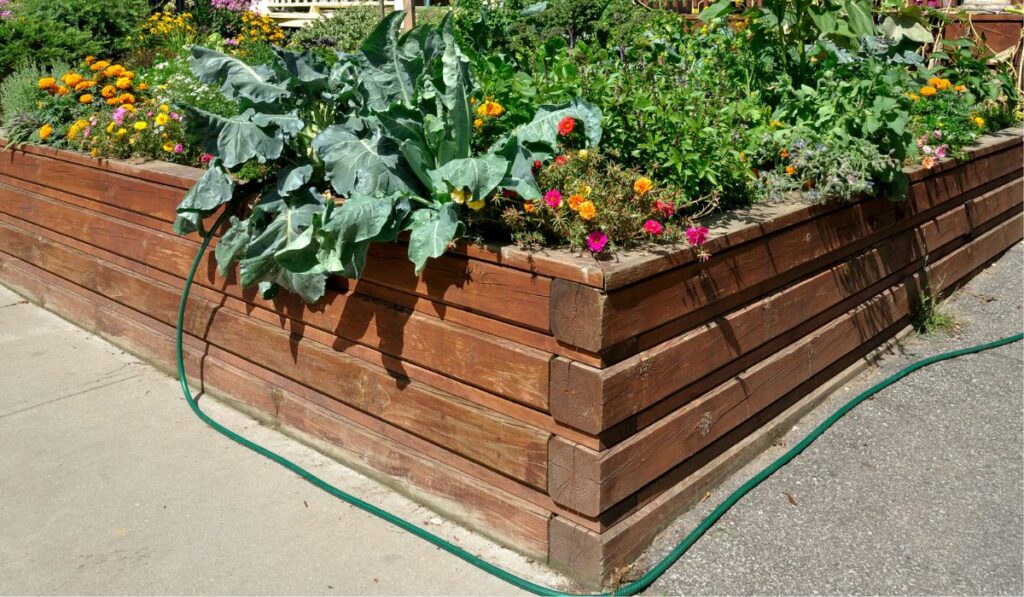
Knowing the measurements of your raised garden bed is vital for both building it and knowing what you can plant. You should first consider the height you want it to be. The height determines how much soil is needed to fill it and how low you want to stoop to tend to the garden.
You can even create a raised garden bed on legs without bending.
That said, there are no required measurements for a raised garden bed. You can customize it to any size that suits your needs and yard. Generally, most raised garden beds fall between 12 and 20 inches off the ground. People with mobility issues like wheelchairs or the inability to bend down tend to have higher beds to make it easier for themselves.
Once the height is determined, you should consider the width. Like the height, knowing the width can help estimate how much soil your garden will need and what plants you can have in that specific garden bed.
The bed should not be wider than three feet to comfortably tend a garden since the average person can only reach 1.5 feet. So from both sides, the entire garden can be comfortably tended.
The length of a garden is typically determined by the space available, though most people tend to settle between four to five feet. If you plan to have multiple garden beds, the average gardener leaves at least 24 inches between each bed for ample walking room.
What Will Be in Your Bed?
Knowing what to plant in your garden goes into two categories: flowers and vegetables. If you want to plant flowers for aesthetic appeal, putting your raised garden bed somewhere more visible will allow you to enjoy the beautiful colors and foliage that flowers produce.
It doesn’t have to be right and center for vegetables and fruits, but there is some consideration on what to plant. For example, root vegetables, leafy greens, tomatoes, and potatoes all do well in raised garden beds. You can even disperse those leafy greens in between slower-growing vegetables like bell peppers to optimize your space.
One thing to consider when planting is the height your vegetables will grow. For example, you want to put that tall tomato plant in the back with the carrots in the front. This may not make sense now, but once you harvest, you will quickly find that it’s harder to get to the carrots to pull them from the ground when you have to navigate through bushes of tomato plants.
Which Areas of Your Yard Get the Most Sunlight?
Sunlight is one of the most important factors when trying to grow plants. So it makes sense to consider it when determining where the bed should go and, ultimately, which part of your yard gets the most ideal sunlight. Your raised garden bed should receive at least six hours of daylight each day to maintain healthy plants regardless of what you want to grow.
You will want to ensure it’s on the south side of tall buildings like houses, garages, sheds, or fences that could obscure the sunlight for a part, if not the entire day. This is especially important for the winter months, which can have the sun lower on the horizon and completely cast your garden in the shade.
If your yard doesn’t allow for at least six to eight hours of sunlight, then you can still have a raised garden bed; there need to be some adjustments in what you can grow. For example, sticking to herbs or leafy greens will grow better in a shaded garden since they tolerate less than ideal sunlight.
Will it Have Legs or Stay Connected to the Ground?
When building a raised garden bed, one must determine whether it will have legs or stay on the ground. Both are good options; it only depends on your individual needs and your native soil.
Raised Garden Bed with Legs

A raised garden bed with legs offers the best accessibility for people with mobility issues. Those in wheelchairs won’t need to bed over and can be right up beside the edge to tend to their gardens. However, young children may be unable to help you garden if it is too high for them to reach.
Raised garden beds also offer better control of animals like deer or rabbits and prevent them from picking at the vegetables.
That said, vegetables like pumpkins, zucchini, and squash may not be ideal for this type of garden as they tend to go over the sides. Also, if they hang in the air, as the vegetable matures, it could become too heavy and fall or snap the vine.
A Raised Garden Bed on the Ground
A raised garden bed on the ground offers a greater depth in the soil since extensive root systems could penetrate the native soil and use it to continue to grow. No bottom stops their growth, like a garden bed on legs. Great plants for this kind of bed are root vegetables and tomatoes.
However, if your native soil is too sandy, too dense, or too heavy, it might not be ideal to let your plants try to grow into it. This could cause root rot or poison the plant with its heavy metals if the soil doesn’t have the correct pH.

